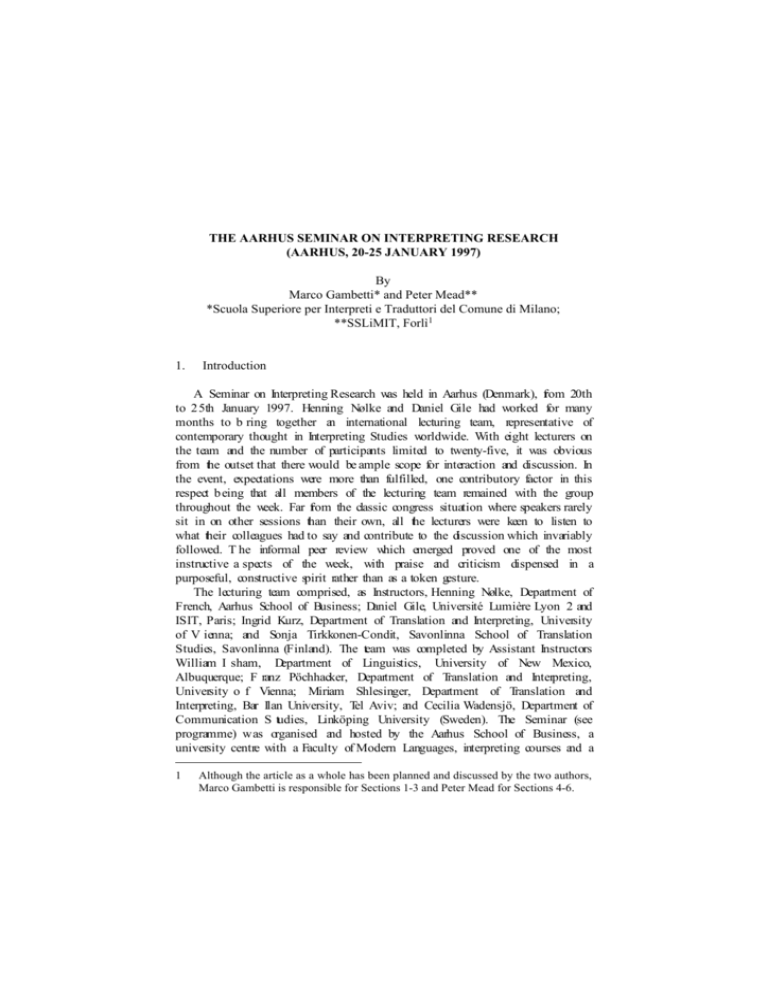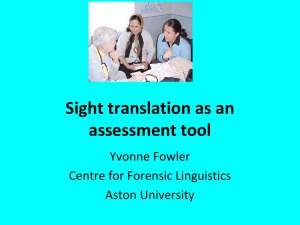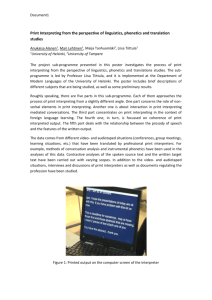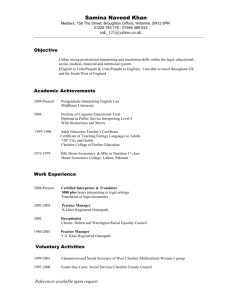THE AARHUS SEMINAR ON INTERPRETING RESEARCH
advertisement

THE AARHUS SEMINAR ON INTERPRETING RESEARCH (AARHUS, 20-25 JANUARY 1997) By Marco Gambetti* and Peter Mead** *Scuola Superiore per Interpreti e Traduttori del Comune di Milano; **SSLiMIT, Forlì1 1. Introduction A Seminar on Interpreting R esearch was held in Aarhus (Denmark), from 20th to 2 5th January 1997. Henning Nølke and Daniel Gile had worked for many months to b ring together an international lecturing team, representative of contemporary thought in Interpreting Studies worldwide. With eight lecturers on the team and the number of participants limited to twenty-five, it was obvious from the outset that there would be ample scope for interaction and discussion. In the event, expectations were more than fulfilled, one contributory factor in this respect b eing that all members of the lecturing team remained with the group throughout the week. Far from the classic congress situation where speakers rarely sit in on other sessions than their own, all the lecturers were keen to listen to what their colleagues had to say and contribute to the discussion which invariably followed. T he informal peer review which emerged proved one of the most instructive a spects of the week, with praise and criticism dispensed in a purposeful, constructive spirit rather than as a token gesture. The lecturing team comprised, as Instructors, Henning Nølke, Department of F rench, Aarhus School of Business; Daniel Gile, Université Lumière Lyon 2 and IS IT, P aris; Ingrid Kurz, Department of Translation and Interpreting, University of V ienna; and Sonja Tirkkonen-C ondit, Savonlinna School of Translation S tudies, S avonlinna (F inland). The team was completed by Assistant Instructors William I sham, Department of Linguistics, University of New Mexico, Albuquerque; F ranz Pöchhacker, Department of Translation and Interpreting, University o f Vienna; Miriam Shlesinger, Department of Translation and Interpreting, Bar Ilan University, Tel Aviv; and Cecilia Wadensjö, Department of C ommunication S tudies, Linköping University (Sweden). The Seminar (see programme) w as organised and hosted by the Aarhus School of Business, a university centre with a Faculty of Modern Languages, interpreting courses and a 1 Although the article as a whole has been planned and discussed by the two authors, Marco Gambetti is responsible for Sections 1-3 and Peter Mead for Sections 4-6. 170 Marco Gambetti and Peter Mead doctoral programme. Though the event was intended mainly for Ph. D. students with research p rojects on interpreting, interpreting teachers and practising interpreters interested in interpreting research were also encouraged to apply. 2. General research issues The first day, at the Aarhus School of Business, provided a general introduction to research principles, strategies and issues. Participants were welcomed by Karen M. Lauridsen, Dean of the Faculty of Modern Languages at Aarhus, after which the morning's proceedings were led by Henning Nølke and Daniel Gile. This tandem arrangement allowed alternation between the essentially complementary approaches of the two speakers, with Nølke pinpointing the prerequisites for scientific research and Gile stating his equally firm insistence on the burden of proof shouldered by the "practisearchers" who combine research interests with professional and teaching activities. While the speakers obviously differ in how and why they entered the field of interpreting research, both were unswerving in their insistence on rigorous, clear reasoning. Issues discussed during this first morning were: definitions of science (Nølke); the requirements for individual research efforts (Gile); classification of fundamental research approaches (Nølke); facts, data and theory (Nølke); and the role of inferential statistics (Gile). The opening presentation by Henning Nølke, a linguistics scholar and Head of the French Department at Aarhus, highlighted the criteria on the basis of which the researcher's approach can be considered truly scientific (carefully planned, systematic, impartial, logical, critical, open to sharing of knowledge, communicative). The contributions to research afforded by observation, theorising, explanation and description were all briefly discussed, the message being that, whatever the approach or focus, the researcher cannot eschew the basic criteria on which work is judged as science or mere speculation. The second of Nølke's three contributions to this opening session offered a concise guide to the dichotomies customarily used for the classification of scientific research (i.e. the distinction between basic and applied; deductive and inductive; observational and experimental; analytical and holistic), explaining the advantages and limitations of each approach. The current emphasis on more empirical research in Interpreting Studies was clearly identified. Finally, in his third presentation of the morning, Nølke explained why it is in practice artificial to maintain a rigid vision of facts, data and theory as mutually exclusive definitions, further developing his remarks from the first part of the morning on the advantages of combining "naturalistic" research (no theory-driven interference with objective observation) and deductive reasoning (more targeted research, less subject to cluttering with extraneous detail). An exclusively The Aarhus Seminar on Interpreting Research 171 naturalistic approach runs the risk of eschewing all control or selectivity, while "pure" experimentation can involve the equally insidious danger of focusing excessively (or even irrelevantly!) on isolated phenomena. Daniel Gile's presentations during this opening session defined the type of goal that a researcher, even if short on experience, can realistically set out to achieve. Gile argues that the accent should be firmly placed on the concrete priorities which can help the aspiring researcher see the wood rather than merely flounder among the trees. Points to underline in this respect include sensitivity to local/national research/publication practice; scope for innovative ideas and methods, irrespective of results, even with small projects; and the potential role of replication, both as a legitimate complement to existing studies and as a form of practice for the less experienced researcher. In the final presentation of the morning, Gile examined the usefulness of inferential statistics, though cautioning the uninitiated on the need for expert guidance. During the afternoon, the introductory session continued with advice from Gile on the importance of criticism during the drafting of a thesis or report, the need for careful choice of project and the role of interdisciplinary research. The comments on criticism afforded an example of the speaker's insistence on balanced analysis, including a discussion of the need to recognize and place in perspective reasons other than valid scientific objections which might incur negative comment from a research supervisor. The talk also addressed possible sources of error, the benefits of constructive criticism at the right time, the usefulness of knowing who can best offer this and the question of whether criticism necessarily calls for a justification of the points it challenges. Gile then shifted the focus to his second topic of the afternoon, the reading of scientific papers and theses. Here again, the analysis proved exhaustive and stimulating, with the accent on the need to identify clearly what one is looking for. This implies bearing clearly in mind from the outset whether the papers are to be read as a potential source of information, as the basis for inclusion in a review or bibliography, as a means of learning from other researchers' strengths and weaknesses, or with a view to providing authors with feedback in the form of reports and suggestions. Various points to be assessed were discussed in detail. Concerning the choice of research project, Gile examined the various issues involved in feasibility, again stressing the learning value of projects with simple objectives and methods. This part of the session closed with a brief review of the criteria ensuring consistency and clarity in scientific writing, such as well defined planning and objectives, coherent reasoning, careful checking of facts and citations, explicit statement of sources, overall clarity in stating one's case, an appropriate space/value ratio to ensure that the length of each section is 172 Marco Gambetti and Peter Mead commensurate with its importance to the study as a whole, careful checking of the bibliography, and attention to details of format and presentation. The last part of the session raised the issue of interdisciplinarity. Here, while willingness to range across conventional epistemological frontiers was encouraged, participants were cautioned against doing so too hastily. Failure to recognise this can mean the embarrassment of finding one's knowledge is patchy, or of playing second fiddle to peers from more prestigious, longer established disciplines. The basic message was that, if prior homework is not neglected, interdisciplinary work is a rewarding experience. 3. The relevance of Translation Studies From the second day, proceedings continued at a residential teaching centre a few kilometres outside Aarhus. Here, the initial session included presentations by Sonja Tirkkonen-Condit, Ingrid Kurz and Bill Isham. In her opening presentation, Sonja Tirkkonen-Condit presented a comprehensive account of the differences between three well established movements in translation studies: the "linguistic" approach (exemplified by Catford or by the Leipzig School), the "historical-descriptive" approach (as in the work of Toury or of Nord) and the "new" integrated approach (examples of which are provided by the work of Pym and Mossop). Tirkkonen-Condit complemented this overview with what she dismissed as her "shopping list" for the newcomer to Translation Studies – a detailed hand-out showing how each of the different approaches to the discipline can be broken down in terms of its attitude to a number of key issues (epistemology, conception of language, relevant linguistics, etc.). The last part of the presentation gave particular emphasis to the "prototypical" concept so characteristic of the "integrated" approach, identifying this as a means of reconciling prescriptive and descriptive perspectives on translation. Sonja Tirkkonen-Condit addressed the group again during the afternoon session of the second day, this time on the subject of the "Think Aloud Protocols" ("TAP") by which the translator's thoughts and hesitations regarding the translation process are explicitly stated. The use of these protocols highlights the translator's self-questioning in the linguistic no-man's-land between competence and performance, or between Toury's "adequacy" and "acceptability". Obviously, the analysis must distinguish between "routine" and "non-routine" translation tasks (with which the translator understandably feels more diffident), as well as between the "prototypical" production of professionals and amateurs. Among the research projects which have thrown interesting light on such questions are a number of protocol studies on Finnish and English in theses defended at Savonlinna. While acknowledging the limitation that these protocols can obviously not go beyond conscious The Aarhus Seminar on Interpreting Research 173 introspection, the speaker's concluding remarks underlined their value as a means of identifying the often conflicting priorities of faithfulness to the source text, compliance with target language norms and, last but emphatically not least, the constraints of the translator's brief. In this respect, the TAP methodology addresses issues potentially relevant to interpreting research. 4. The advantages of interdisciplinarity and some examples The remaining two presentations of the second day were by Ingrid Kurz and Bill Isham, both representing the link between interpreting studies and psychology. Ingrid Kurz addressed the subject of interdisciplinary research, proposing the Socratic term "maieutic" to define the potential contribution of interpreting studies to the emergence of innovative research in fields such as cognitive psychology, communication sciences, sociolinguistics or artificial intelligence. Indeed, Kurz's professional training and experience afford her a vantage point which encompasses interpreting, interpreter training and cognitive psychology. Her arguments for an interdisciplinary approach to interpreting studies are thus based on personal experience. Relevant points highlighted in this presentation included "procedural" and "declarative" knowledge, "topdown" processing in the assimilation of discourse or text, and the mnemonic role of "chunking". Kurz identified the psychological interest of interpreter training, with particular reference to albeit controversial techniques such as shadowing, interpreting while counting or performing simple mathematical tasks, controlled décalage, "cloze testing" and intralingual interpretation (paraphrasing). The final part of the presentation included a retrospective glance at the speaker's 1969 doctoral thesis, still an acknowledged landmark as the first by a practising interpreter in the then little explored field of Interpreting Studies. B ill I sham's presentation maintained the focus on the potential synergy between interpreting studies and cognitive psychology. The speaker first presented a number of remarks on the definition, epistemology and main components of cognitive s cience. Isham's presentation also provided a complement to the previous day's sessions on science, in that it examined central research concepts regarding the distinction between dependent and independent variables, the need to m ake allowance for a "noisy" environment and the role of experimental or statistical controls. Another point on which Isham's presentation complemented Henning N ølke's remarks of the previous day was the principle, seemingly paradoxical to the unscientific mind, that a "strong" theory should be potentially falsifiable; b y contrast, a theory leaving no room for testing (which might ultimately d isprove it) cannot contribute to the systematic advancement of scientific k nowledge. Isham also highlighted the need to focus on specific variables amidst the overall complexity of the interpreting process, as a means of 174 Marco Gambetti and Peter Mead ensuring s ystematic generation and testing of hypotheses. The issue of significance t esting was also addressed, the extent of a phenomenon being appreciated in perspective only if sample size is appropriate. Thus, a small effect in a small sample is not in itself informative; according to whether the effect increases or simply disappears in the context of a larger sample, its true extent can be better appreciated. Finally, with regard to linguistic activity and interpretation, the speaker focused on the concept of mental or cognitive load and of the need to reconcile t he conflicting demands of memory and representation on limited cognitive resources. The programme for the morning of Wednesday 23rd January comprised three lectures, two by the previous day's speakers (Kurz and Isham) and one, on the relevance of sociolinguistic paradigms, by Cecilia Wadensjö. The afternoon was dedicated to two round tables, the first on issues in interdisciplinary research, the second on the use of research literature. In t he day's opening lecture, Ingrid Kurz gave an account of electroencephalographic ( EEG) studies on simultaneous interpreting, examining the theoretical b ackground, methodology and current status of this research. Complementing her remarks of the previous day on an interdisciplinary approach, the speaker acknowledged t he invaluable scientific and methodological input provided by P rofessor Hellmuth Petsche of Vienna University's Institute of Neurophysiology. The at first sight "artificial" use of mental translation, as opposed to actual i nterpreting (to avoid muscle artifacts in the EEG resulting from articulatory movements), does not seem to prevent clear experimental confirmation of differences in cerebral lateralization for languages A and B. (S imilar conclusions were drawn previously by Laura Gran and Franco Fabbro from studies involving dichotic listening and finger-tapping. ) Kurz stressed that the interest of the EEG images i s not restricted to identifying the regions involved in the translation process, but also gives a telling indication of interhemispheric connectivity. In the second talk of the morning, Bill Isham commented on the interest of signed languages for interpreting research. Isham's professional experience as an interpreter of ASL (American Sign Language) and his research activities at the University of New Mexico place him among the "practisearchers" exemplified by Ingrid Kurz and Daniel Gile; a varied academic background also affords him access to the thick of the interdisciplinary fray, with the advantage of a foot in both the linguistics and cognitive science camps. The speaker presented his observations on the differing degrees of verbal recall by interpreters according to whether their medium of expression is speech or gesture (i.e., in working towards signed language). The data from the experiment described show less verbal recall in spoken language interpreters than their signed language counterparts. Isham tentatively suggests, as a possible explanation, the need for spoken language interpreters to divide listening attention between the source The Aarhus Seminar on Interpreting Research 175 discourse and feedback of their own production – signed language obviously not competing for any such aural monitoring. Also of interest in this presentation was the demonstration of why ASL is linguistically far more complex than signed English, meaning the gestured representation of individual words and/or their spelling. Isham's research has, in fact, contrasted the two against the background of the meaning-based/form-based distinction. 5. Other approaches and perspectives: recent/ongoing doctoral studies During the final part of the morning, Cecilia Wadensjö gave an account of how discourse analysis affords insight into the role of the interpreter as mediator. The p resentation offered an example of a viable research area within which to identify P h. D. projects, being based on the speaker's 1992 doctorate. Wadensjö's inductive study of how a Swedish police inspector, a Russian-speaking defendant and t heir interpreter each make sense of verbal interaction from their respective points o f view reminded participants that not all interpreting research need be concerned with the workings of the so-called "black box". Wadensjö began by clarifying the differences between the concepts of language as text production by the speaker and as a form of interaction, highlighting the advisability of balancing the two a pproaches. The reasons for not relying exclusively on a "discourse as text" analysis w ere identified as threefold: comprehension presupposes active participation by the listener; purely linguistic analysis may miss the point of the focal event of interaction; and the "discourse as text" approach risks spilling over into value judgments on compliance with a "normative" conception of language. In Wadensjö's example, the interpreter is no less involved than the defendant and police officer in what Goffman-based terminology refers to as the "participation framework"; like them, the interpreter thus establishes a "footing" which indicates whether and how (s)he takes responsibility for the progression and content of their verbal interaction. The afternoon of the third day was dedicated to two round tables, on issues in interdisciplinary research and the reading of scientific papers. The first of these discussions featured a number of observations on the epistemology of interpreting studies and the consequent need for interpreting research to be at least partly based on a solid interdisciplinary footing. The second round table offered advice on the scientific literature, with reference above all to theses and journals. The f ourth day of the Seminar began with talks by Franz Pöchhacker and Miriam S hlesinger, who both gave a brief account of their research interests. P öchhacker's opening comments on his early experience of interpreting research – complete with wry but pertinent caricatures – were appreciated not only for the scientific r igour of the work presented, but also for the honest, balanced 176 Marco Gambetti and Peter Mead encouragement o ffered. The talk included a brief account of how Pöchhacker collected t he corpus for his 1992 doctoral thesis, with an explanation of the functionalist theoretical approach on which the analysis was based. One example P öchhacker chose to illustrate his "functionalist" approach was that of explicitly professional o r academic forms of address such as "Doctor" or "P rofessor", eschewed by E nglish language delegates at the congress analysed but promptly introduced by the German language interpreters. By briefly commenting on the epistemological setting of his research, the speaker also illustrated how studies can actually be defined in terms of the "basic"/"applied", "theoretical"/ "empirical" and o ther dichotomies mentioned during the week. In addition to its intrinsic scientific i nterest, Franz Pöchhacker's presentation complemented Cecilia Wadensjö's as an example of a relatively recent doctorate. Daniel Gile, while not questioning t he scientific quality of the work, expressed the reservation that transcribing a nd then analysing an entire three-day technical conference is a formidably labour-intensive lead-in for a doctoral project. Miriam S hlesinger's talk also provided an example of research towards a doctorate, offering a clear, simple and accessible account of the speaker's work. After some introductory remarks on her 1989 M.A. thesis (examining the relative positions o f source and target language speeches on a continuum of style and register b etween oral and formal/literary expression), Shlesinger presented the doctorate work on which she is currently engaged. The starting point for the study in q uestion is the simple syntactic difference between the relative positions of adjective and s ubstantive which characterise noun phrases in English (adj + subst.) a nd Hebrew (subst. + adj. ). Miriam Shlesinger uses this difference to examine the "working memory" of the interpreter, obliged when translating from English i nto Hebrew to wait for – and translate – the final substantive of the source language noun p hrase before actually starting to list the adjectives in Hebrew. This means that the interpreter may be forced to give over considerable working memory resources to the storage of multiple adjectives, placed before the noun in English but necessarily after it in the Hebrew translation. In addition to this a ccount of her own work, Shlesinger emphasized her keen, analytical approach to identifying – and sharing – research topics. 6. "All good things ..." The final sessions of the week included a morning of discussion, in the form of a round table and a workshop, followed by individual tuition, informal presentations of research projects by participants 2 and final remarks by Daniel 2 These presentations, not discussed in the present paper, are listed in a report of the Seminar by Elvira Basel, "Research-Based Teaching", in The Jerome Quarterly, 12/2 (1997: pp. 8-9). The Aarhus Seminar on Interpreting Research 177 Gile and Henning Nølke. The subject of the round table was the role of the research supervisor and of peers in offering criticisms and suggestions, while the workshop focused on discussion of scientific papers given out at the beginning of the week. This session, guided by Daniel Gile, was a significant feature of the week, in that participants were not informed of the authors or dates of the texts provided for discussion. As in a "blind" wine tasting, there was thus no reason to hold back because of automatic deference to known names or vintages. The papers discussed actually included an article, little known to a mainstream interpreting readership, by one of the Aarhus speakers. Advice dispensed earlier in the week about seeking – and accepting – criticism was thus seen not to have been intended in a merely rhetorical spirit! At the end of the week, the consensus of opinion among participants was that, in offering guidance for those interested or engaged in postgraduate research on interpretation, the Aarhus Seminar had made an innovative contribution to the promotion of Interpreting Studies and to the creation of an even more broadly based research network, driven by shared values and personal interaction. Henning Nølke and Daniel Gile are to be thanked for the work they put into the event, as are the entire team of instructors. Helle Dam, Friedel Dubslaff, Bodil Martinsen and Anne Schjoldager deserve credit not only for handling the organisational requirements prompted by such an event, but also for helping create a hospitable atmosphere conducive both to study and to informal discussion. Though the message of the Seminar cannot be fairly represented in a few words, great emphasis was placed on the need to appreciate the dangers of sweeping, intuitive conclusions and to maintain a responsible, critical attitude to received wisdom. Another important message was the timely reminder, throughout the week, of how the relationship with a research supervisor should be centred on a two-way input. In conclusion, it is to be hoped that the Aarhus organisers will schedule similar events again and that a future edition will be organised for another group of potential Interpreting Studies Ph.D. candidates. Though participation in the 1997 Seminar was by no means limited to those actually involved in doctoral projects, perhaps it could also be useful in future to offer a course more specifically for teachers of interpreting who have had no opportunity to engage in research or, indeed, for interpreters without academic affiliations. Possibly different user groups could even be accommodated together, though this would obviously require careful thinking as to how sessions could be differentiated and co-ordinated to fulfil differing requirements. F or those who participated in the 1997 event, the benefit of Aarhus continues to be appreciated a s the lessons learnt become more fully assimilated and new 178 Marco Gambetti and Peter Mead research c ontributions emerge, broadening of scientific contacts being prerequisite for the continuing development of Interpreting Studies. a Acknowledgements Comments received from the Aarhus Seminar speakers on an earlier draft of this article are gratefully acknowledged, as are editorial suggestions from The Interpreters' Newsletter. Any remaining inaccuracies or misrepresentations are entirely the responsibility of the authors. Bibliography The recommended reading list for the Seminar, reproduced below, affords a representative introduction to the issues presented by each speaker and access to more detailed bibliographies. Gile D. (1990): "Scientific research vs. personal theories in the investigation of interpretation", in Aspects of Applied and Experimental Research on Conference Interpretation. Ed. by L. Gran & C. Taylor, Udine, Campanotto, pp. 28-41. Gile D. (1991): "Methodological aspects of interpretation (and translation) research", in Target 3:2, pp. 153-174. Isham W.P. (1994): "Memory for sentence form after simultaneous interpretation: evidence both for and against deverbalization", in Bridging the Gap. Empirical Research in Simultaneous Interpretation. Ed. by S. Lambert & B. Moser-Mercer, Amsterdam, Benjamins, pp. 191-211. Kurz I. (1994): "A look into the "black box" — EEG probability mapping during mental simultaneous interpreting", in Translation Studies: An Interdiscipline. Ed. by M. Snell-Hornby, F. Pöchhacker & K. Kaindl, Amsterdam, Benjamins, pp. 199-207. Kurz I. (1994): "Interdisciplinary research — difficulties and benefits", Target 7:1, pp. 165-179. Nølke H. (1994): Linguistique Modulaire: de la Forme au Sens. Louvain, Peeters, pp. 13-32 and 213-223. Pöchhacker F. (1995): "Simultaneous interpreting: a functionalist perspective", Hermes, Journal of Linguistics, n. 14, pp. 31-53. Shlesinger M. (1994): "Intonation in the production and perception of simultaneous interpretation", in Bridging the Gap. Empirical The Aarhus Seminar on Interpreting Research 179 Research in Simultaneous Interpretation. Ed. by S. Lambert & B. Moser-Mercer, Amsterdam, Benjamins, pp. 225-236. Shlesinger M. (1995): "Shifts in cohesion in simultaneous interpretation", The Translator 1:2, pp. 193-214. Tirkkonen-Condit S. (1989): "Theory and methodology in translation research", in Empirical Studies in Translation and Linguistics. Ed. by S. Tirkkonen-Condit & S. Condit, University of Joensuu, Faculty of Arts, pp. 3-18. Tirkkonen-Condit S. (1989): "What is in the black box? Professionality in translational decisions in the light of TAP research", in Übersetzungswissenschaft im Umbruch. Ed. by A. Lauer, H. Gerzymisch-Arbogast, J. Haller & E. Steiner, Tübingen, Narr, pp. 251-257. Wadensjö C. (1995): "Dialogue interpreting and the distribution of responsibility", Hermes, Journal of Linguistics, n. 14, pp. 111-129. 180 Marco Gambetti and Peter Mead





